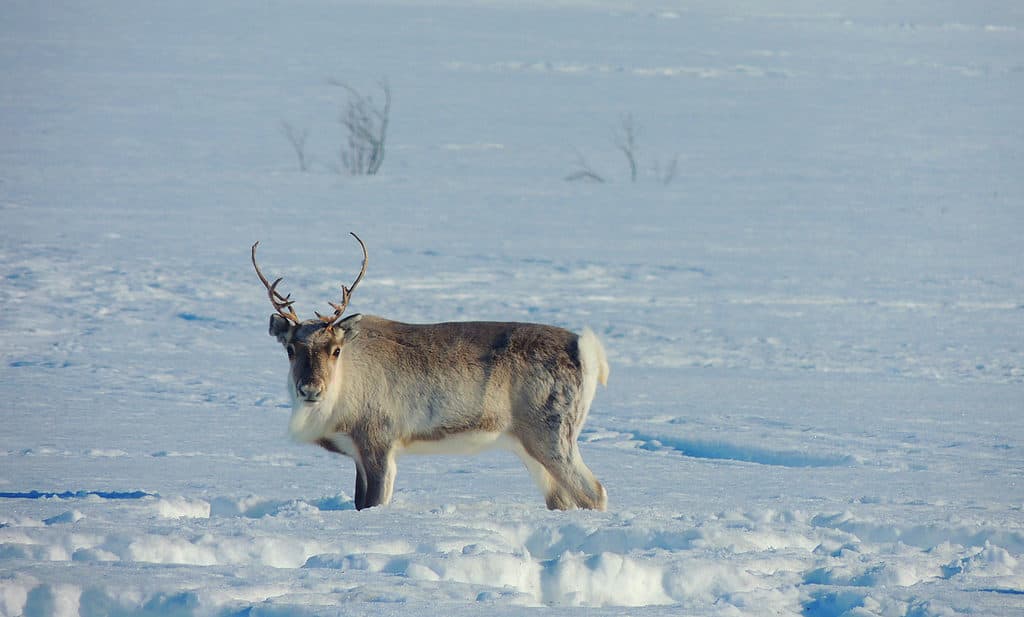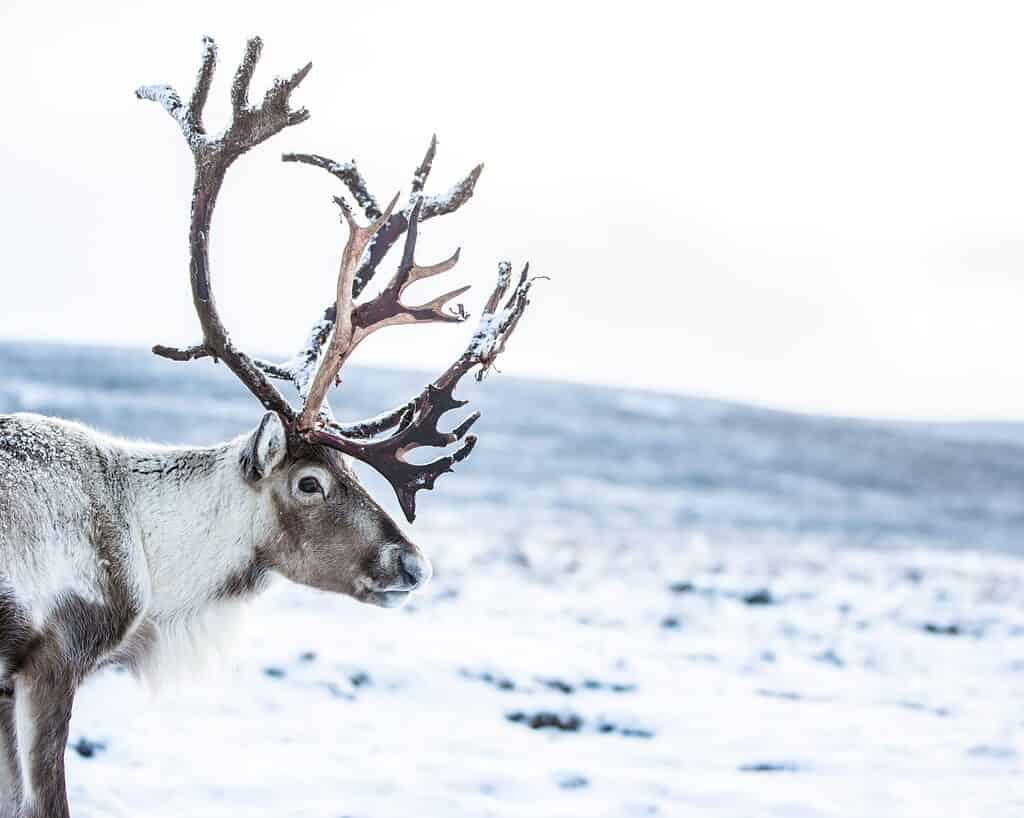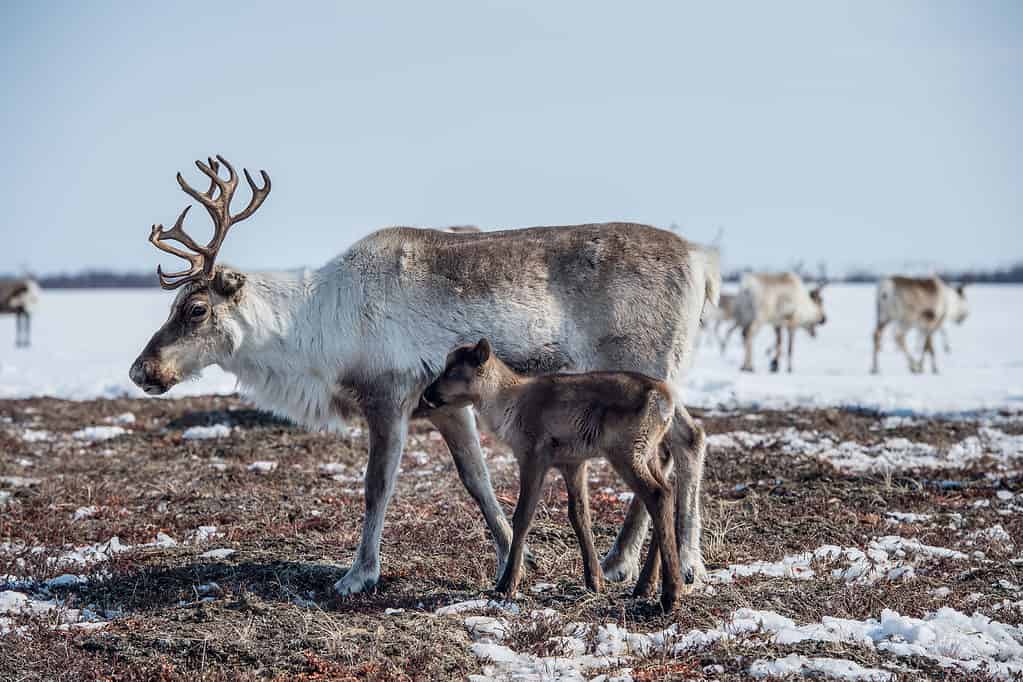Reindeer are fascinating animals. They can easily spot predators thanks to their ability to see ultraviolet light, and some reindeer migrate the farthest of any terrestrial animal.
To this day, there is still much confusion about whether reindeer are deer. The truth is deer and reindeer are closely related: all reindeer are deer but not the other way around. Keep on reading to learn more about their differences and how they evolved to be unique!

Deer differ to reindeer in several ways including their habitat, antlers, legs and coat.
©WildMedia/Shutterstock.com
Are Reindeer Actual Deer?
We usually call deer any member of the Cervidae family, of which there are more than 43 species. Reindeer are one of the species of deer, which in turn has 10 subspecies of its own. We can then say that yes, reindeer are, in fact, deer.
This does not mean that they are the same thing, however. Reindeer have many peculiarities that set them apart from the rest. Most of these traits developed as a way to endure the harsh conditions of the Arctic tundra and boreal forests and are today the reason reindeer are among the few species that can survive in the Arctic Circle.

Reindeer are among the few species that can survive in the Arctic Circle.
©MJShepherd/Shutterstock.com
How To Tell a Deer From a Reindeer
The easiest way to tell a reindeer from a deer is the climate it inhabits; deer are creatures accustomed to temperate climates, while reindeer evolved to thrive in freezing environments. This means that if you find yourself in colder regions like Siberia, you will likely spot reindeer instead of regular deer.
Another quick way to know if you are dealing with a reindeer is by checking its antlers. Reindeer antlers tend to be massive compared to the animal’s body, while regular deer have a more balanced antler-to-body ratio. They also characteristically branch in groups, clearly separating the top from the bottom. In contrast, regular deer antlers are pointier and branch slightly more horizontally.
You will also notice that reindeer have different legs: they are stockier, and their hooves are larger and split in such a way it allows for more effortless movement in difficult terrain. Of course, these are not the only things that make reindeer unique. In the following sections, we will dive further into their characteristics.

Reindeer antlers tend to be massive compared to the animal’s body and characteristically branch in groups.
©Rezu_07/Shutterstock.com
Reindeer vs. Deer: How Different Are They?
Generally, reindeer are not too different from deer when it comes to their behavior, except for one crucial aspect: reindeer are the only species of deer to be successfully domesticated. Scandinavian and Russian natives have used these animals for transportation, food, and sustenance for centuries. Deer, on the other hand, are far more skittish and reluctant to be domesticated, which means almost every single deer you encounter will be wild.
Apart from the social aspects, reindeer differ from regular deer in certain physical qualities. For starters, reindeer evolved to be cold hardy, a characteristic clearly reflected in their fur, which is denser and somewhat coarser than a regular deer’s. Another survival mechanism unique to reindeer is their nose. They have a particular bone structure, where their turbinate bones allow them to heat incoming air before it reaches their lungs.
One of the most noticeable differences between deer and reindeer is that reindeer are the only type of deer in which the females grow antlers. In all other subspecies of deer, only the males grow antlers, which they use primarily in competition and defense against predators. In the case of reindeer, it is believed females have antlers to help them scavenge for food in the snow.

Reindeer is the only type of deer in which the females grow antlers.
©den-sau-pin/Shutterstock.com
How Did Reindeer Evolve?
The reindeer we know today started taking form millions of years ago. In fact, it is believed that reindeer shared a common ancestor with humans during the dinosaur age, nearly 100 million years ago!
The major shifts in reindeer evolution happened during the last Ice Age when the Northern Hemisphere became covered in massive ice sheets, and animals had to either adapt or leave. This is when mountain deer start to change biologically to survive the extreme conditions of the world, acquiring many of the traits we see today on reindeer.
Here are some of the most important developments:
- Shorter and stronger legs, so they could outrun large predators and travel huge distances searching for food and warmth.
- Broader snouts with specialized bones to heat up the freezing air they inhale.
- Larger hooves that can grow and shrink to fit the season, making it easier to traverse through ice and snow. Their hooves also gained a particular shape that allows them to unearth food in the dirt or snow.
- Female reindeer grow antlers too, which becomes essential as a tool to forage food when there is scarcity in the tundra.
- Capacity to digest lichen and fungi to obtain glucose — convenient since lichen covers a large percentage of the Arctic surface.
- Lack of Circadian Clock, a mechanism that helps animals and humans set a regular sleep and wake cycle depending on sunlight hours. Because of this, reindeer can ignore the extreme variations in the length of days in the Arctic to respond better to the environment and fulfill their needs.
- A tapetum lucidum — a layer of tissue behind the retina that works as a reflector and helps reindeer see better in the dark.
- Better vitamin D production, a vitamin secreted thanks to sun exposure. Reindeer need plenty of this vitamin to regrow their antlers, so they evolved to process it about 20 times more efficiently than most other mammals.

Reindeer have a particular bone structure, where their turbinate bones allow them to heat incoming air before it reaches their lungs.
©Arh-sib/Shutterstock.com
Reindeer were domesticated by humans around 3,000 years ago, and since then, they have helped native populations in the Arctic survive and prosper against all odds. Their defining characteristics have made them unique in the animal kingdom and are the reason they can survive comfortably today in Earth’s coldest regions.
Up Next
- Why Do Female Reindeer Have Antlers?
- Baby Reindeer: What They’re Called & 5 Facts
- Reindeer vs. Deer – 8 Key Differences Explained
- Caribou Migration: What Is It and Why Do They Do It?
The photo featured at the top of this post is © Dmitry Chulov/Shutterstock.com
Sources
- PEDIAA, Available here: https://pediaa.com/difference-between-deer-and-reindeer
- HAL Open Science, Available here: https://hal.archives-ouvertes.fr/hal-01737207/document
- Science, Available here: https://www.science.org/content/article/how-reindeer-evolved-survive-freezing-arctic-winters
Thank you for reading! Have some feedback for us? Contact the AZ Animals editorial team.






